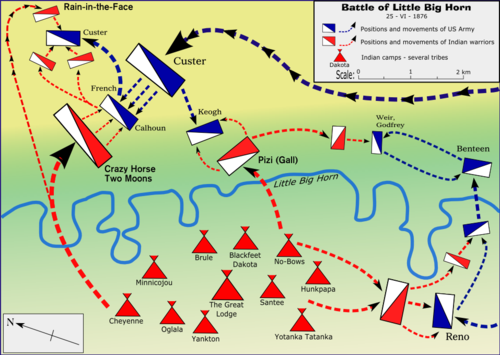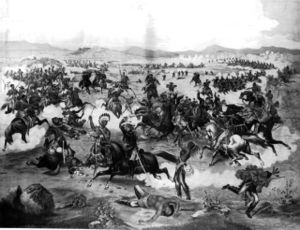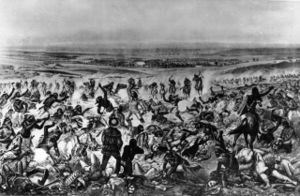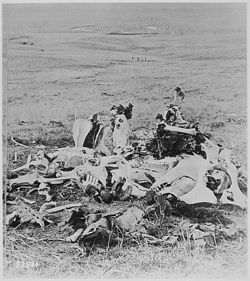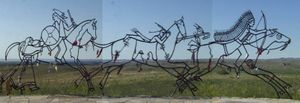Battle of the Little Bighorn
2007 Schools Wikipedia Selection. Related subjects: Pre 1900 Military
| Battle of the Little Bighorn | |||||||
|---|---|---|---|---|---|---|---|
| Part of the Black Hills War | |||||||
 Custer Massacre at Big Horn, Montana — June 25, 1876, artist unknown |
|||||||
|
|||||||
| Combatants | |||||||
| Lakota, Northern Cheyenne, Arapaho |
United States | ||||||
| Commanders | |||||||
| Sitting Bull, Crazy Horse |
George Armstrong Custer † | ||||||
| Strength | |||||||
| 949 lodges (probably 950-1200 warriors) | 31 officers, 566 troopers, 15 civilians, ~35-40 scouts |
||||||
| Casualties | |||||||
| ~200 killed (according to Yellow Horse, Red Horse and Little Buck Elk and latest NPS researchs) | ~268 killed (16 officers, 242 troopers, ~10 civilians/scouts), ~55 wounded |
||||||
| Black Hills War |
|---|
| Powder River – Rosebud – Little Bighorn – Warbonnet Creek – Slim Buttes – Cedar Creek – Dull Knife Fight – Wolf Mountain |
The Battle of the Little Bighorn — which is also called Custer's last stand and Custer Massacre and, in the parlance of the relevant Native Americans, the Battle of the Greasy Grass — was an armed engagement between a Lakota- Northern Cheyenne combined force and the 7th Cavalry of the United States Army. It occurred June 25– June 26, 1876, near the Little Bighorn River in the eastern Montana Territory.
The battle was the most famous incident in the Indian Wars and was a remarkable victory for the Lakota and Northern Cheyenne. A U.S. cavalry detachment commanded by Lt. Col. George Armstrong Custer was annihilated.
Prelude to battle
Background
Forces from the Army were sent to attack the Native Americans based on Indian Inspector E.C. Watkins' report (issued on November 9, 1875) that claimed that hundreds of Lakota and Northern Cheyenne associated with Sitting Bull and Crazy Horse were hostile to the United States.
Thousands of Indians had indeed slipped away from their reservations through early 1876. Military officials planned a three-pronged expedition to corral them and force them back to the reservations, using both infantry and cavalry, as well as small detachments of artillery, including Gatling guns. Brig. Gen. George Crook's column moved north from Fort Fetterman in the Wyoming Territory toward the Powder River area. Col. John Gibbon's column marched east from Fort Ellis in western Montana Territory. The third column under Brig. Gen. Alfred Terry, including George Custer's 7th Cavalry, departed westward from Fort Abraham Lincoln in the Dakota Territory. However, on June 17, Crook's column was defeated at the Battle of the Rosebud and forced to stop and regroup. Gibbon and Terry proceeded, joining forces in late June near the mouth of the Rosebud River. Terry and Gibbon formulated a plan that called for Custer's regiment to proceed up the Rosebud River, while Terry and Gibbon's united columns would proceed up the Big Horn and Little Big Horn rivers. The officers hoped to trap the Indian village between the two forces.
Custer's force arrived at an overlook 14 miles (23 km) east of the Little Bighorn River in what is now the state of Montana, on the night of June 24, as the Terry/Gibbon column was marching toward the mouth of the Little Big Horn.
7th Cavalry deployment
The 7th had previously served four-and-a-half years at Ft. Riley, Kansas, during which time it fought one major engagement and numerous skirmishes, experiencing casualties of 36 killed and 27 wounded. 6 other troopers had died of drowning and 51 from cholera epidemics.
Fully half of the 7th Cavalry had just returned from eighteen months of constabulary duty in the deep South, having been recalled to Fort Abraham Lincoln to reassemble the regiment for the campaign. Approximately 20% of the troopers had been enlisted in the prior seven months (139 of an enlisted roll of 718), were only marginally trained, and had no combat or frontier experience. A sizable number of these recruits were immigrants from Ireland, England, and Prussia, as had been many of the veteran troopers prior to their enlistments. Several men were veterans of the American Civil War, including many of the leading officers.
Of the 44 officers and 718 troopers then assigned to the 7th Cavalry (including a second lieutenant detached from the 20th Infantry and serving in L Troop), 13 officers (including the regimental commander, Col. Samuel D. Sturgis, who was on detached duty) and 152 troopers did not accompany the 7th during the campaign. Among those left behind at Fort Abraham Lincoln were the regimental band.
After discovering a large trail on June 15, the 7th Cavalry split from the remainder of the Terry column on June 22 and began a pursuit along the trail. Following a night forced march on June 24– 25, in which Crow Indian scouts reported to Custer the presence of what was judged a very large encampment of Indians, Custer divided the 7th Cavalry into four detachments.
The largest detachment consisted of Troops C, E, F, I, and L, personally led by Custer. It numbered 13 officers, 198 men (7 of whom would eventually be detached before the "last stand") and three civilians—a newspaper reporter, and two scouts. Two of Custer's relatives would later join the column. Troop C was commanded by Custer's brother, Capt. Thomas Custer, and L Company by his brother-in-law, 1st Lt. James Calhoun. This detachment marched along a ridge line on the east bank of the Little Big Horn in an attempt to enter the encampment from the north.
A second detachment, led by Maj. Marcus Reno, was sent into the Little Big Horn valley to provoke an engagement. This detachment consisted of Troops A, G, and M, and numbered 11 officers, 131 troopers, and most of the approximately 35 Sioux, Ree/ Arikara and Crow scouts.
A third detachment was led by a company commander, Capt. Frederick Benteen, and was made up of Troops D, H, and K, with 5 officers and 110 men. Its mission was to scout within supporting distance of either of the other columns or to attack any body of Indians it encountered.
The last group was the regimental pack train, consisting of 7 or 8 troopers from each company and escorted by Troop B. Commanded by Captain Thomas McDougall, this sizable force had 2 officers, 127 troopers, and 7 civilian packers.
Each of the first three detachments was to seek out the Indian encampments, attack them, and hold them in place until the other two detachments arrived to support. Custer had employed similar tactics in 1868 during the Battle of the Washita.
The Battle
Reno's attack
The first detachment to attack was Major Reno's, conducted after receiving orders from Custer delivered by Lt. William W. Cooke. The orders, made without accurate knowledge of the village's size, location, or propensity to stand and fight, were to pursue the Indians and "bring them to battle". However, Custer did promise to "support...[Reno] with the whole outfit". Reno's force crossed the Little Bighorn at the mouth of what is today called Reno Creek and immediately realized that the Lakota and Northern Cheyenne were present "in force and ...not running away".
Sending a message to Custer, but hearing nothing in return, Reno advanced rapidly northward, stating that he drove the enemy "with ease". However, he suspected "a trap" and stopped a few hundred yards short of the encampment, dismounting and deploying in a skirmish line, as standard army doctrine called for. In deploying in a skirmish line, every fifth trooper handled the horses for four troopers taking firing positions, thus immediately reducing the fighting force by 20%. The troopers on the skirmish line were positioned five to ten yards apart, with officers just to their rear and the troopers with horses behind the officers. After about 20 minutes of long distance firing he had taken only one casualty but the odds against him had become more obvious (Reno estimated five to one) and Custer had not reinforced him. Reno ordered a withdrawal into nearby woods in a loop of the river, then made a disorderly retreat across the river to reach the high ground of the bluffs on the other side. The retreat was confused and immediately disrupted by Cheyenne attacks at close quarters. Reno later reported that 3 officers and 29 troopers were killed during the retreat and the subsequent fording of the river and another officer and 13-18 men missing, left behind in the woods, although most of these men eventually rejoined the detachment.
Atop the bluffs, Reno's shaken troops soon linked up with the detachment of Captain Benteen, arriving from the south. This force had been on its lateral scouting mission when it had been summoned by a messenger from Custer to "Come on...big village, be quick...bring pacs...". (This messenger was John Martin, a trumpeter, who was the last white person to see Custer alive and survive the battle.) Benteen's coincidental arrival on the bluffs was just in time to save Reno's men from possible annihilation. Their detachments were then reinforced by McDougall and the pack train. The 14 officers and 340 troopers on the bluffs organized an all-around defense and dug rifle pits.
Despite hearing heavy gunfire from the north, Benteen concentrated on reinforcing Reno's badly wounded battalion, rather than continuing on towards Custer. There was documented conversations between Benteen and Reno taking note of the similarity in Custer's strategy to that used years earlier at the Battle of the Washita. There, when his position looked threatened, Custer retreated instead of supporting one of his sub-commanders, Major Joel Elliot, resulting in the complete annihilation of Elliot's unit. Benteen wondered if history had just repeated itself and Custer had abandoned them to possible annihilation. Benteen was heard to say "I wonder if this is to be another Maj. Elliot affair?" (See Hardoff, Camp; and Nichols, Reno Court.)
After an hour, nearing five o'clock and the end of the Custer fight, Capt. Thomas Weir and Company D moved out against orders to make contact with Custer. They advanced a mile and could see Lakota shooting in the distance, but were under considerable pressure themselves. The other companies eventually followed by assigned batalions, first Benteen, then Reno, and finally the pack train, but growing Lakota attacks forced all seven companies to return to the bluff before the pack train, with the ammunition, had moved even a quarter mile. Benteen's apparent reluctance prompted later criticism that he had failed to follow orders.
Custer's fight
The gunfire heard on the bluffs was from Custer's fight. His force of 208 was engaged by the Lakota and Northern Cheyenne approximately 3.5 miles (6 km) to the north. Having driven Reno's force away from the encampment and isolated it, many warriors were free to pursue Custer. The route taken by Custer to his "Last Stand" remains a subject of debate. It does seem clear that after ordering Reno to charge, Custer continued down Reno Creek to within about a half mile (800 m) of the Little Bighorn, but then turned north, and climbed up the bluffs, reaching the same spot to which Reno would soon retreat. From this point, he could see Reno, on the other side of the river, charging the village.
Custer then rode north along the bluffs, and descended into a drainage called Medicine Tail Coulee, which led to the river. Some historians believe that part of Custer's force descended the coulee, going west to the river and attempting unsuccessfully to cross into the village. Other authorities believe that Custer never approached the river, but rather continued north across the coulee and up the other side, where he gradually came under attack. By the time Custer realized he was badly outnumbered by the Indians who came from the Reno fight, according to this theory, it was too late to break through back to the south, where Reno and Benteen could have provided reinforcement.
Within roughly three hours, Custer's force was completely annihilated. Only two men from the 7th Cavalry later claimed to have seen Custer engage the Indians: a young Crow whose name translated as Curley, and a trooper named Peter Thompson, who had fallen behind Custer's column, and most accounts of the last moments of Custer's forces are conjecture. Lakota accounts assert that Crazy Horse personally led one of the large groups of Lakota who overwhelmed the cavalrymen. While exact numbers are difficult to determine, it is commonly estimated that the Northern Cheyenne and Lakota outnumbered the 7th Cavalry by approximately 3:1, a ratio which was extended to 5:1 during the fragmented parts of the battle. In addition, some of the Indians were armed with repeating Spencer and Winchester rifles, while the 7th Cavalry carried single-shot Springfield carbines, which had a slow rate of fire, tended to jam when overheated, and were difficult to operate from horseback.
The terrain of the battlefield gave Lakota and Cheyenne bows an advantage, since Custer's troops were pinned in a depression on higher ground from which they could not use direct fire at the Indians in defilade. On the other hand, the Lakota and Cheyenne were able to fire their arrows into the depression by launching them on a high arching indirect fire, with the volume of arrows ensuring severe casualties. U.S. small arms might have been more accurate over open distances, but the fighting on this occasion was close combat where rate of fire and reliability of a weapon were more important attributes.
Recent archaeological work at the battlefield site indicates that Custer initially deployed his troops in skirmish lines per Army doctrine. This deployment would have resulted in only approximately 150 troopers providing defensive fire over several long skirmish lines. As individual troopers were killed, wounded or their carbines jammed, the skirmish lines became untenable.
While many of Custer's troops were recruits who did not possess an adequate level of military training and skill, archaeological evidence also suggests that they were undernourished, in poor physical condition, and had been on forced march nearly 24 hours without sleep at the commencement of the engagement.
The Fight on the Bluffs
After the Custer force was annihilated, the Lakota and Northern Cheyenne regrouped to attack Reno and Benteen. The fight continued until dark (approximately 9:00 p.m. by local timekeeping) and for much of the next day, with the outcome in doubt. Reno credited Benteen's leadership with repulsing a severe attack on the portion of the perimeter held by Companies H and M. On June 26 the column under Terry approached from the north, and the Indians drew off in the opposite direction. The wounded were given what treatment was available at that time; five later died of their wounds. Two of the regiment's three surgeons had been with Custer's column; the remaining doctor was assisted by interpreter Fred Gerard.
An examination was made of the Custer battle site. The Indian dead had mostly been removed from the field. The 7th's dead were identified as best as possible and hastily buried where they fell. Custer was found to have been shot in the left temple and in the left chest; either wound would have been fatal. He also suffered a wound to the arm. Some Lakota oral histories assert that Custer committed suicide to avoid capture and subsequent torture or death—as Custer believed—but he was right-handed. His body was found near the top of "Last Stand Hill" where a large obelisk inscribed with the names of the 7th's dead now stands. Most of the dead had been stripped of their clothing, mutilated, and were in an advanced state of deterioration, such that identification of many of the bodies was impossible.
From the evidence, it was impossible to determine what exactly had transpired, but there was not much evidence of prolonged organized resistance. Several days after the battle, the young Crow scout Curley gave an account of the battle which indicated that Custer had attacked the village after crossing the river at the mouth of Medicine Tail Coulee and had been driven back across the river, retreating up the slope to the hill where his body was later found. This scenario seemed compatible with Custer's aggressive style of warfare, and with some of the evidence found on the ground, and formed the basis for many of the popular accounts of the battle.
Unfortunately (for Custer and his troops), this aggressive action was deeply flawed as a military tactic. First, Custer did not have adequate information (or did not believe it) on the size of the Lakota/Cheyenne encampment. According to Herman Viola's 1998 book on the battle, Custer's Crow scouts did tell Custer the encampment was far too large to be attacked, and began to change into their native dress, because they did not want to die dressed in white man's uniforms. When Custer asked his famed Indian Scout, Mitch Bouyer, why the Crow scouts were changing, Bouyer told him the scouts believed the attack on the village would be fatal to them all.
Custer then released the Crow Scouts, including Curley and White Man Runs Him, from their duty. (White Man Runs Him was the first to tell General Terry's officers that Custer's force had "been wiped out".) The element of surprise in the 7th Cavalry attack may have been able to overcome a slightly larger force, but not a force roughly five times as large. Second, Custer did not know the terrain from which he would attempt his attack. Custer, according to Lakota/Cheyenne sources, was never able to get any part of his battalion across the river to the encampment. Custer's troops were never able to concentrate their firepower on the Lakota/Cheyenne forces. Third, Custer set his regiment up for "defeat in detail" by dividing it into three smaller battle units (the troops assigned to the pack train were a necessary part of any battle plan), that could not quickly support each other. None of the battalions was large enough to win a major engagement, due to the standard skirmish line deployment in battle. In addition, many of the Native American warriors had far better weapons than the U.S. cavalry soldiers.
Estimates of Lakota and Cheyenne casualties widely vary, from as few as 36 dead (listings of dead by name) to as many as 300. The 7th Cavalry suffered 52% casualties: 16 officers and 242 troopers killed or died of wounds, one officer and 51 troopers wounded. Every soldier in Custer's detachment was killed. The sole survivor that was found by General Terry's troops was Captain Keogh's horse Comanche. By July, the 7th cavalry had been restocked with officers and new recruiting efforts were underway. It would again take the field in pursuit of its adversaries, but its legacy remains the Little Bighorn.
For further details on participants and casualties, see below.
Inquiries into the causes for the defeat
In 1878, the army awarded 24 Medals of Honour to participants in the fight on the bluffs for bravery, most for risking their lives to carry water from the river up the hill to the wounded. Few questioned the conduct of the enlisted men, but many questioned the tactics, strategy, and conduct of the officers, particularly Major Reno.
The battle was the subject of an army Court of Inquiry, made at Reno's request, in 1879 in Chicago, in which Reno's conduct was scrutinized. Some testimony was presented suggesting that he was drunk and a coward, but since none of this came from army officers, Reno was not officially condemned. Other factors have been identified which may have contributed to the outcome of the fight: it is apparent that a number of the cavalry troopers were inexperienced and poorly trained. Benteen has been criticized for "dawdling" on the first day of the fight, and disobeying Custer's order. Both Reno and Benteen were heavy drinkers whose subsequent careers were truncated. Terry has been criticized for his tardy arrival on the scene.
Pvt. William Taylor wrote to Lt. Edward Godfrey on February 20, 1910: "Reno proved his incompetence and Benteen showed his indifference—I will not use the words I've often thought about. Both failed Custer and he had to fight it alone."
For years a debate raged as to whether Custer himself had disobeyed Terry's order not to attack the village until reinforcements arrived. Finally, almost a hundred years after the fight, a document surfaced which indicated that Terry actually had given Custer considerable freedom to do as he saw fit. Custer's widow Libby actively affected the historiography of the battle by suppressing criticism of her husband. A number of participants decided to wait for her death before disclosing what they knew; however, she outlived almost all of them. As a result, the event was recreated along tragic Victorian lines in numerous books, films and other media. The story of Custer's purported heroic attack across the river, however, was undermined by the account of participant Gall, who told Lt. Edward Godfrey that Custer never came near the river. Godfrey incorporated this into his important publication in 1892 in The Century Magazine. In spite of this, however, Custer's legend was embedded in the American imagination as a heroic officer fighting valiantly against savage forces, an image popularized in "Wild West" extravaganzas hosted by showman "Buffalo Bill" Cody.
By the end of the 20th century, the general recognition of the mistreatment of the various Indian tribes in the conquest of the American West, and the perception of Custer's role in it, have changed the image of the battle and of Custer. The Little Bighorn is now viewed by some as a confrontation between relentless U.S. westward expansion and warriors defending their land and way of life.
Battlefield preservation
The site was first preserved as a national cemetery in 1879, to protect graves of the 7th Cavalry troopers buried there. It was redesignated Custer Battlefield National Monument in 1946, and later renamed Little Bighorn Battlefield National Monument in 1991.
Memorialization on the battlefield began in 1879 with a temporary monument to U.S. dead. This was replaced with the current marble obelisk in 1881. In 1890 the marble blocks that dot the field were added to mark the place where the U.S. cavalry soldiers fell. The bill that changed the name of the national monument also called for an Indian Memorial to be built near Last Stand Hill. On Memorial Day 1999, two red granite markers were added to the battlefield where Native American warriors fell. As of June 2005 there are now a total of 10 warrior markers (three at the Reno-Benteen Defense Site, seven on the Custer Battlefield).
7th Cavalry Officers at the Little Big Horn
- Commanding Officer: Lt. Colonel George Armstrong Custer killed
- Major Marcus Reno
- Adjutant: 1st Lt. William W. Cooke killed
- Assistant Surgeon George Edwin Lord, killed
- Acting Assistant Surgeon James Madison DeWolf, killed
- Acting Assistant Surgeon Henry Rinaldo Porter
- Chief of Scouts: 2nd Lt. Charles Varnum wounded
- 2nd in command of Scouts: 2nd Lt. Luther Hare detached from K Company
- Pack Train commander: 1st Lt. Edward Mathey detached from M Company
- A Company: Captain Myles Moylan, 1st Lt. Charles DeRudio
- B Company: Captain Thomas McDougall, 2nd Lt. Benjamin Hodgson killed
- C Company: Captain Thomas Custer killed, 2nd Lt. Henry Moore Harrington killed
- D Company: Captain Thomas Weir, 2nd Lt. Winfield Edgerly
- E Company: 1st Lt. Algernon Smith killed, 2nd Lt. James Sturgis killed
- F Company: Captain George Yates killed, 2nd Lt. William Reily killed
- G Company: 1st Lt. Donald McIntosh killed, 2nd Lt. George Wallace
- H Company: Captain Frederick Benteen, 1st Lt. Francis Gibson
- I Company: Captain Myles Keogh killed, 1st Lt. James Porter killed
- K Company: 1st Lt. Edward Godfrey
- L Company: 1st Lt. James Calhoun killed, 2nd Lt. John J. Crittenden killed
- M Company: Captain Thomas French
Crittenden was on loan to the 7th Cavalry from the 20th U.S. Infantry, since the cavalry regiment was short on officers.
Civilians killed
- Boston Custer: brother of George & Thomas, Forager for the 7th, killed
- Mark Kellogg: Reporter, killed
- Henry Armstrong Reed: Nephew of Custer's, Herder for the 7th, killed
- Frank C. Mann: Packer, killed during the fight on the bluffs
Notable Scouts/Interpreters in the battle
- Charley Reynolds: Scout for the 7th, killed
- Bloody Knife: Arikara/Lakota Scout for the 7th, killed
- Curley: Crow Scout for the 7th
- Mitch Bouyer: Scout/interpreter for the 7th, killed
- Isaiah Dorman: Interpreter for the 7th, killed
- Fred Gerard: Interpreter for the 7th
- White Man Runs Him: Crow Scout for the 7th
- Goes Ahead: Crow Scout for the 7th
- Hairy Moccasin: Crow Scout for the 7th
- White Swan: Crow Scout for the 7th
- Half Yellow Face: Crow Scout for the 7th
Prominent Native Americans in the battle
- American Horse (Miniconjou Lakota)
- Buffalo Calf Road Woman (Cheyenne)
- Chief Crow, (Sioux)
- Minnie Hollow Wood, (Lakota)
- Crazy Horse (Oglala Lakota)
- Curley (Crow)
- Gall (Hunkpapa Lakota)
- Goes Ahead, (Crow)
- Hairy Moccasin, (Crow)
- He Dog (Oglala Lakota)
- Hump (Minniconjou Lakota), wounded
- Lame White Man (Cheyenne), killed
- Moving Robe Woman (Hunkpapa Lakota)
- One Who Walks With the Stars (Oglala Lakota)
- Rain-in-the-Face (Hunkpapa Lakota)
- Short Bull (Brulé Lakota)
- Sitting Bull (Hunkpapa Lakota) spiritual leader in the camp, but non-combatant
- Two Moons (Cheyenne)
- White Bull (Sioux)
- Wooden Leg (Cheyenne)
- Black Elk {Oglala Lakota}
- Red Horse {Sioux}
- White Bull {Sioux}

